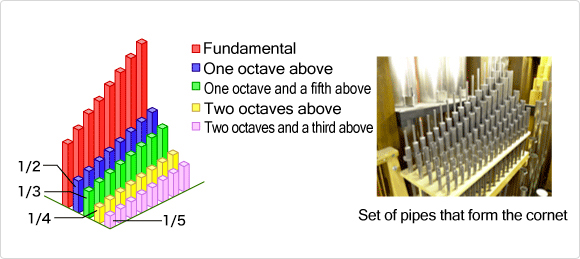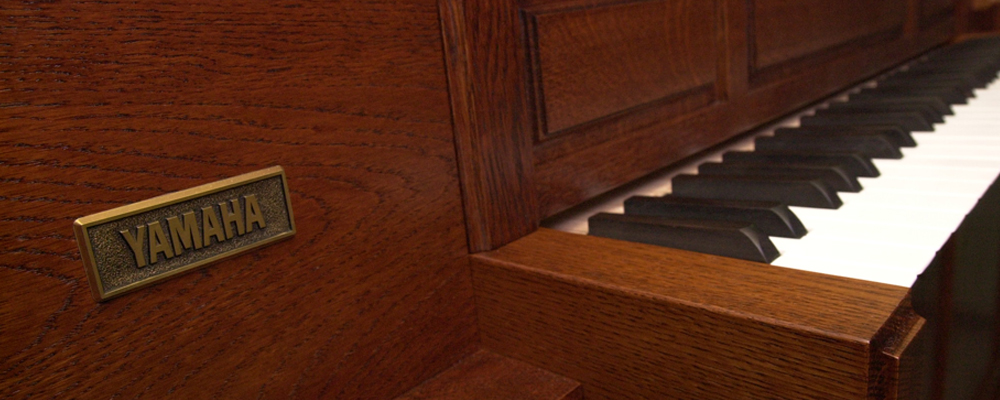How to Play the Pipe organ
Producing a variety of timbres
The range of the pipe organ
Because pipe organs are made to suit the space where they will be installed, they differ in a number of ways such as their size, the number of pipes and manuals, and other aspects. Because of the variety of timbres that can be selected, as well as manuals for both hands and feet, the instrument can play an exceedingly broad range.
Modern instruments use a 12-tone equal temperament scale, with one octave divided into 12 tones.

Example range of a pipe organ
A unique way to adjust volume
With the manual of a pipe organ, the volume and timbre of the notes is unchanged whether they are played forcefully or gently. The fullness of the sound produced is proportionate to the number of stops used, allowing a distinction between stronger and more gentle sounds to be expressed. In other words, this can be thought of in terms of adding sound.
The case of the instrument can also be used to reduce the volume of sound produced. Regulation of volume is achieved by opening and closing the swell shutters, a structure resembling a vertical blind that can enclose some of the pipes within the case. The organist can operate the shutters with a pedal to control the volume, which becomes quieter or louder as the shutters are closed or opened.

Swell shutters opened to their full extent (90 degrees) and completely closed, controlled by the use of a pedal
Combining timbres to make new sounds
>With the pipe organ it is possible to make new sounds by combining timbres.。
For example, playing a melody with a single flute timbre produces a nostalgic sound, but playing the same melody simultaneously at an octave interval produces a light yet firm sound. This is the same as the relationship between a piccolo and a flute in an orchestra. The pitch of these two sounds is exactly one octave apart.
One manual can play five sounds!
Among the stops of the organ there is one with a uniquely high pitch. For example, there is one stop constructed to play five pipes of the same timbre simultaneously, at intervals of one octave above, one octave and a fifth above, two octaves above, and two octaves and a third above, in addition to the fundamental.
The length of the pipes are 1/2, 1/3, 1/4 and 1/5 of the length of the pipe for the fundamental, respectively. Accordingly, if the single key for C is pressed on the manual while such a stop is used, it is possible to play pipes varying in interval, for C, C, G, C and E, at the same time.

Example range for a pipe organ
When pipes at different intervals are played together, this might generally be thought of as producing a chord, but in the case of the pipe organ these blend together to form one sound, developing the timbre to become stronger and more grand.
Different combinations of harmonics are assigned names, with the "cornet" (1 + 1/2 + 1/3 + 1/4+ 1/5) being a representative example.
From the fundamental to the interval two octaves and a third above
All played at once (cornet)
Let's listen to organist Miho Uchiyama play the cornet.
First each pipe is played individually for five tones, then all five are played at once. When played at once, they blend together completely. The demonstration uses the flute timbre.
Combining harmonics
The various timbres of the pipe organ are characterized according to the number and intensity of their harmonics. Harmonics can be sounded on independent pipes, one by one, and by combining these sounds it is possible to create timbres. It is for this reason that characteristic timbres can be produced.
Musical Instrument Guide : Pipe Organ Contents
Origins
How to Play
How the Instrument is Made
Care and Maintenance
Trivia
- Various sizes, from large-scale to pocket-sized
- Can you tell an expensive instrument from its sound?
- Changing fashions in the number of manuals
- Partial bass range
- Delay between play and sound
- Appreciating the aesthetics of churches
- Pipe organ treasures in Tokyo
- Sound that varies according to where it is heard

